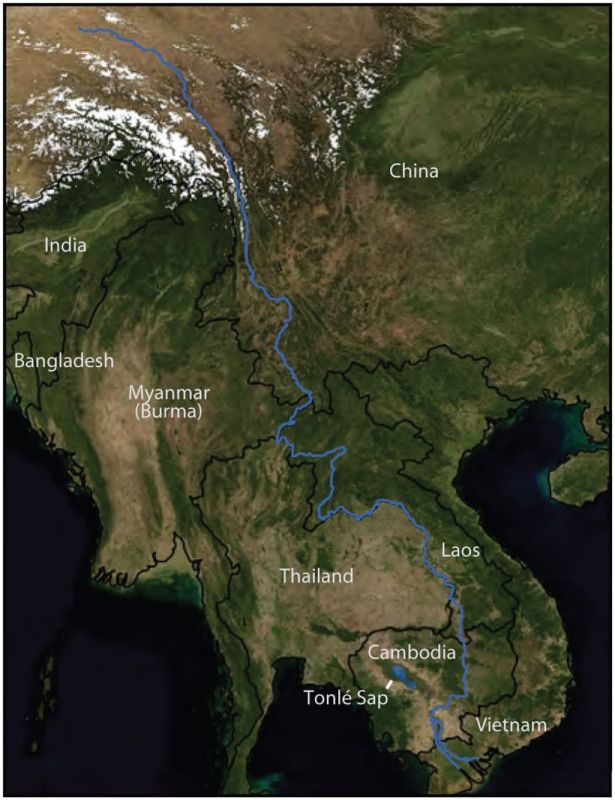UW Project Seeks Sustainable Blueprint for Hydropower Dams
Published on by Water Network Research, Official research team of The Water Network in Academic
Researchers from the University of Washington, Arizona State University and others institutions have proposed a solution that allows dam operators to generate power in ways that also protect — and possibly improve — food supplies and businesses throughout the Mekong River basin.
The proposed solution, the first of its kind, can be applied to other large river systems around the world facing similar tradeoffs.

Mekong River basin.University of Washington
“One of the challenges in dealing with these systems and environmental change is the conversation is largely stuck in, ‘don’t build dams,’ or ‘yes, build dams,'” said Gordon Holtgrieve, a UW assistant professor of aquatic and fishery sciences. “What this does say is, let’s try to find ways we can work together. This won’t solve all the problems, but let’s work to find solutions.”
The paper represents a first step in a large, multiyear project involving researchers across the UW and ASU campuses. Funded by the National Science Foundation’s Innovations at the Nexus of Food, Energy and Water Systems program, the project will use findings in the Mekong River basin as an example of how three critical issues — feeding people, generating energy and maintaining functioning ecosystems — can be addressed thoughtfully and progressively in the developing world.
Every summer in the Mekong River basin, monsoon rains flood the river and delta, increasing by six times the flooded area of Cambodia’s Tonle Sap Lake, the largest lake in Southeast Asia and frequently called the “heart” of the Mekong. The rise and eventual fall of the water triggers the migration of dozens of fish species, which spawn in the upper tributaries during low water. Fish larvae return to the lake on the next flood to grow and mature in its highly productive waters. This yearly pattern provides a critical source of animal protein, and an economy, for the people of Cambodia and other countries along the Lower Mekong.
But with new dams coming online soon, there is no basin-wide effort to coordinate how each dam’s release of water will impact the hydrology of the basin or fish, said Faisal Hossain, a UW professor of civil and environmental engineering and a collaborator on the project.
The goal of the project, involving researchers from fisheries, forestry, engineering, public health and the UW’s Freshwater Initiative, is to gather information about how dam water flow interacts with fish, rice production and nutrition in this region and provide the most useful information to individual countries so that they can decide how best to operate their hydropower dams, he explained.
“We are trying to find a sweet spot for the many stakeholders, who often compete for resources, that can maximize the overall benefits in a way that doesn’t do too much damage to the environment, fish and livelihood of the region,” Hossain said.
One promising option is to use hydroelectric dams to mimic the flood of water from monsoon rains each spring that bring fish to the lake. The team’s algorithm, outlined in the Science paper, recommends long, low-flow periods punctuated by rapid flooding, which would allow dam operators to manage their power generation priorities while protecting fishing economies downstream.
The researchers found that seasonal periods of drought before the annual flood are crucial to producing abundant fisheries in the lake and surrounding streams. When the soil is dry, trees and plants grow, organic matter is produced and the soil is filled with nutrients. When floodwaters rush in, those nutrients are suspended in the water and fish are able to exploit them — drawing more fish to the feast, which in turn benefits fishers.
Holtgrieve, along with several UW colleagues, will study the flooding cycle in connection with the nutritional value of fish and rice, both staples in Southeast Asian diets, to help prioritize certain species and timing for harvesting the most nutritious food. Specifically, he will analyze tissue samples from 50 different fish species covering a range of habitats in the Mekong, measuring for beneficial fatty acids, vitamins and minerals, as well as for harmful elements like mercury.
Read full article: University of Washington
RESEARCH ARTICLE: 'Designing river flows to improve food security futures in the Lower Mekong Basin' HERE
Media
Taxonomy
- Hydrology
- River Studies
- Dams
- Hydrology
- River Engineering